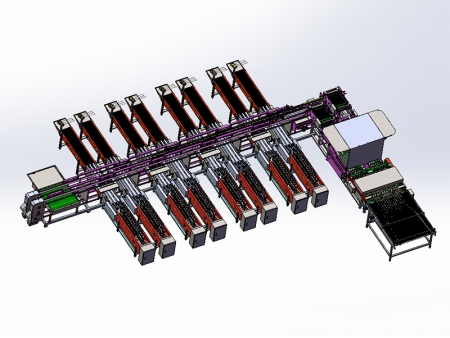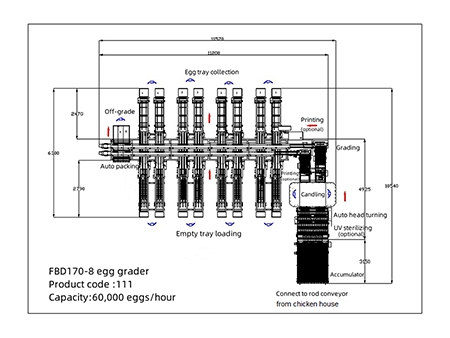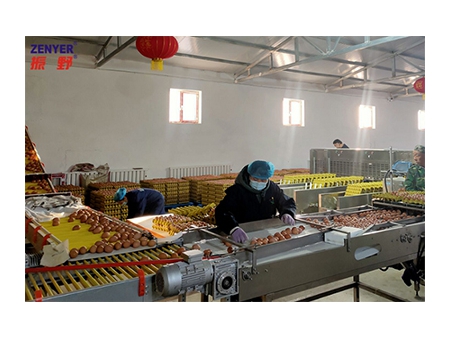111 Egg Grader (60,000 EGGS/HOUR)
Capable of handling up to 60,000 eggs per hour, this model of egg grading and packaging equipment offers high-capacity performance for large-scale operations. This egg grading system combines two , offering egg accumulating, automatic egg turning, LED light inspection, weight grading, counting, automatic egg packing and manual collection.
In addition, we also offer optional features such as an automatic egg loader, UV sterilization, printing, and visual AI inspection, allowing users to customize the system to their specific needs.
The egg grading machine automatically loads eggs into various carton and tray sizes, including 2x5, 2x6, 3x5, 3x6, and 5x6, making it ideal for medium to large-scale poultry farms or egg processing enterprises. Its versatile and high-capacity design ensures it meets the demands of large-scale operations efficiently.
| Name | Egg grader |
| Product code | 111 |
| Model | FBD170-8 |
| Capacity | 60,000 eggs/hour |
| Accuracy | ±1 gram |
| Grade | 4~7 |
| Main material | Stainless steel |
| Power | 13.36KW |
| Voltage | 380~415V, 50Hz, 3-phase |
| Dimension (L*W*H) | 11.57*10.54*2 M |
| Net weight | 4280KG |
| Gross weight | 6150KG |
| Function | Egg accumulating, automatic egg turning, candling, grading & counting, auto packing and manual collection, optional automatic egg loader, UV sterilization, egg printer and visual AI detector |
- Accumulating
- Connection to the rod conveyor/Automatic egg loader (optional)
- Automatic egg turning
- UV sterilization (optional)
- Candling/Visual AI detector processing (optional)
- Grading & Counting
- Egg Printing (optional)
- Automatic packing
- Manual collection
An extra-wide accumulator is used for egg loading/accumulating, with a width that is double that of the standard accumulator used in the Zenyer 109 egg grader. This expanded width allows for greater egg handling capacity, making it ideal for large-scale operations where efficiency and speed are critical.
Connection to the rod conveyorIt is recommended that customers connect the system directly to the rod conveyor leading from the chicken house. Eggs from the rod conveyor will flow directly onto the accumulator. After alignment, the eggs are divided into two sets of 6 lanes, which then move into two 6-lane automatic egg turning devices for further processing. This setup ensures smooth integration and efficient handling, ideal for large-scale egg collection and grading operations.
For situations where direct connection to the central rod conveyor from the chicken house is not feasible due to space constraints, it is recommended to use an automatic egg loader with dual-lifter head for automatic egg loading. You can manually place stacks of egg trays (up to 6 trays per stack) on the tray conveyor. The dual-lifter head will automatically pick up the eggs from the trays and transfer them to the accumulator of the egg grader. After alignment, the eggs are divided into two sets of 6 lanes, which then move into two 6-lane automatic egg turning devices.
Simultaneously, the empty trays will be automatically stacked at the end of the tray conveyor, allowing you to manually remove the neatly stacked trays. This system simplifies the egg loading process, ensuring efficient operation even in limited space conditions.
As the eggs pass through the specially designed turning mechanism, they are automatically oriented to ensure that the larger end, where the air cell is located, faces upwards after packaging. This orientation is crucial as it helps maintain the integrity of the air cell, which is essential for prolonging the eggs' shelf life.
The UV sterilization module is positioned above the automatic egg turning mechanism. This module utilizes ultraviolet light to disinfect the eggshells, providing an additional layer of safety by significantly reducing the risk of contamination. This sterilization process ensures that the eggs meet the highest standards of food safety, making them safer for consumption.
After passing through the two 6-lane automatic turning devices, the eggs enter the two 6-lane LED light inspection units. Each LED inspection unit is installed beneath the rollers, ensuring comprehensive inspection as the eggs move along. The LED light illuminates the eggs, allowing operators to visually identify and manually remove defective eggs, such as those that are cracked, misshapen, dirty, or have black spots.
The rollers are equipped with forced rotation bars that keep the eggs continuously rolling during inspection, ensuring that all sides of the eggs are visible. The inspection units also feature a candling hood and mirrors, allowing operators to see the backside of the eggs and eliminate any visual blind spots. Additionally, curtains are installed at the front and rear of the candling hood, which can be drawn to create a dark room environment, enhancing the effectiveness of the LED inspection process.
The Visual AI detector features a non-contact design that allows for egg scanning without direct handling by operators, significantly enhancing food safety and hygiene. The system is equipped with self-learning capabilities, enabling it to adapt to new standards and requirements by continuously accumulating data and updating its algorithms. By leveraging big data technology, the system learns from extensive historical data, improving detection accuracy and efficiency over time.
The inspector uses near-infrared (NIR) light combined with advanced image processing to achieve automatic egg detection. A camera mounted at the top of the cabinet scans the eggs as they rotate on the feeding rollers. The NIR light strip positioned beneath the rollers allows the camera to capture clearer images, which are then processed by the computer. Any eggs with cracked shells, dirt spots, or other non-compliant features are automatically identified and removed from the processing line, ensuring that only high-quality eggs proceed further.
As the eggs enter the grading process, they are sorted into 4 to 7 weight categories with a grading accuracy of ±1 gram. This process also includes a counting function, which records the number of eggs in each grade, the number processed per shift or day, and the total production output.
The grader is equipped with a color PLC touchscreen, allowing operators to easily adjust the grading weights and other parameters directly on the screen for quick and convenient modifications. It also features a unique intelligent self-diagnosis function that displays fault causes on the screen when issues arise, helping users quickly identify and resolve problems.
Additionally, the grader is equipped with Wi-Fi capabilities, enabling remote monitoring and diagnostics via the internet. In the event of software issues, they can be quickly addressed and resolved through remote access, minimizing downtime and ensuring continuous, efficient operation.
The Zenyer 401H egg printer with 1 print head can be mounted on the single-row egg graders and egg washers. It is activated by a photoelectric sensor as eggs pass underneath, triggering the printing process.
This printer is capable of printing text, numbers, logos, and dates onto the eggs, providing traceability for the eggs' origin. This traceability is crucial for ensuring consumer confidence, as it offers transparency about the quality and source of the eggs.
- Manual tray dispensing
- Automatic tray dispensing
The standard configuration of the Zenyer 111 egg grader includes 8 automatic egg packers and 1 manual collection table. After grading, the eggs are automatically distributed to the appropriate auto packer according to the system settings. Users have the flexibility to increase or decrease the number of automatic egg packers based on their specific needs. The machine can automatically load eggs into various tray sizes, such as 2x5, 2x6, 3x5, 3x6, and 5x6, and users can choose between pulp, plastic, or foam trays based on their requirements. Each automatic packer is dedicated to packaging eggs of a specific grade.
Additionally, empty trays can be manually placed, or users can opt for an automatic de-stacking (automatic tray dispensing) device to further simplify the process.
In addition to the eggs that are automatically packaged, the remaining eggs fall onto the manual collection table. If needed, the manual collection table can be divided into three sections: one section for eggs that are too large or too small, and the other two sections for accommodating eggs from two different grades. This flexible setup allows for efficient manual handling and sorting of eggs that do not fit the automatic packaging criteria.




